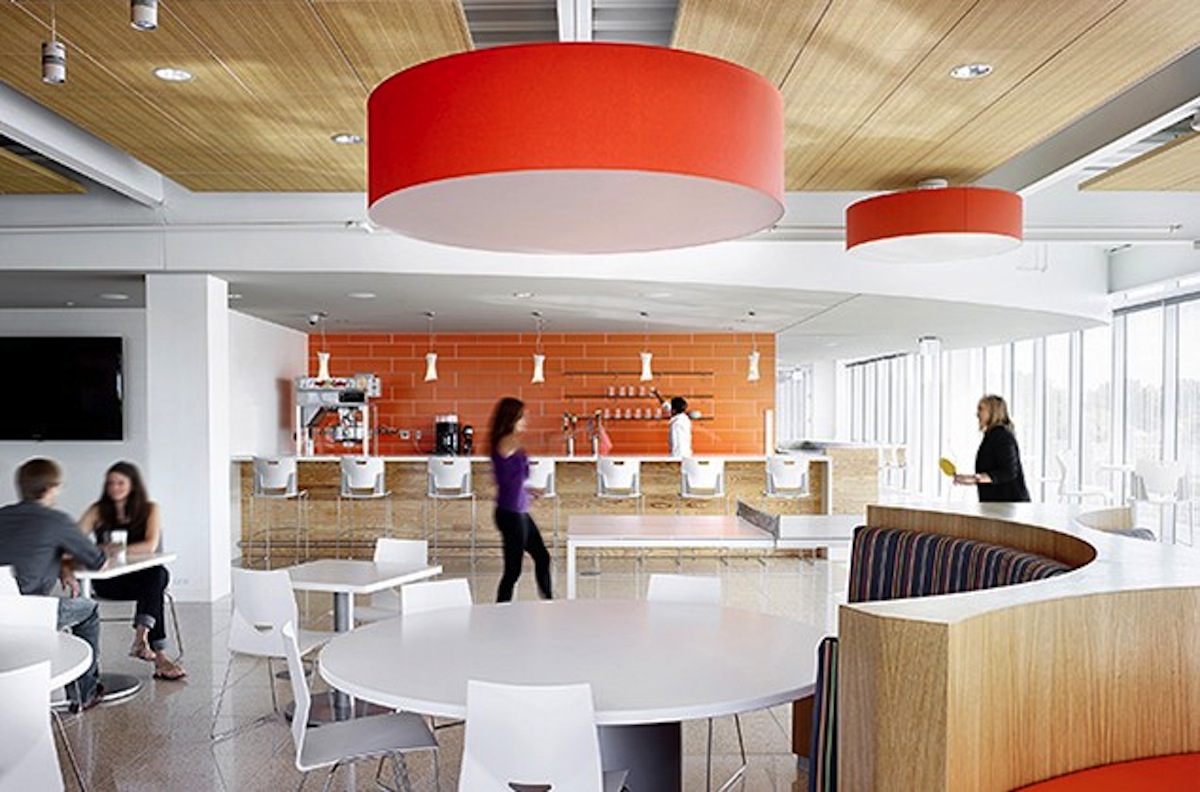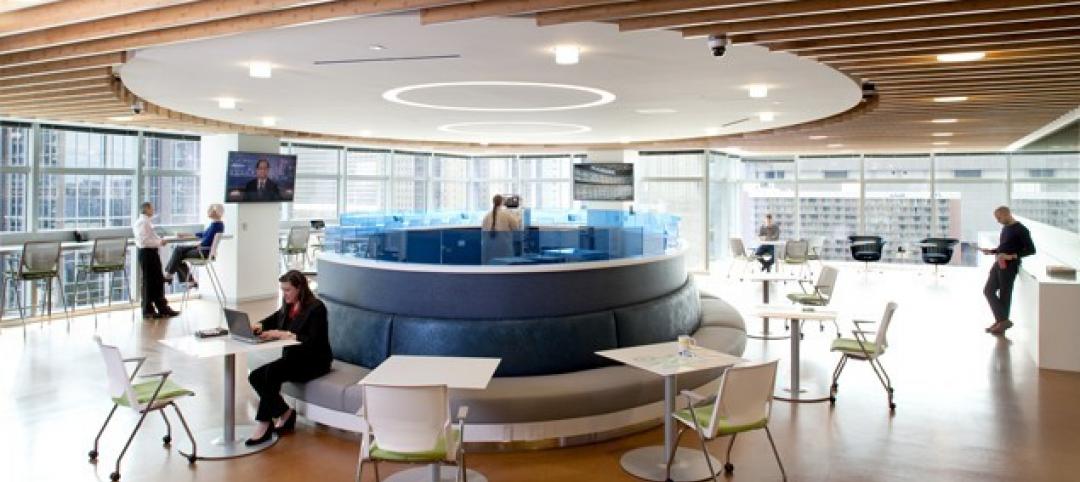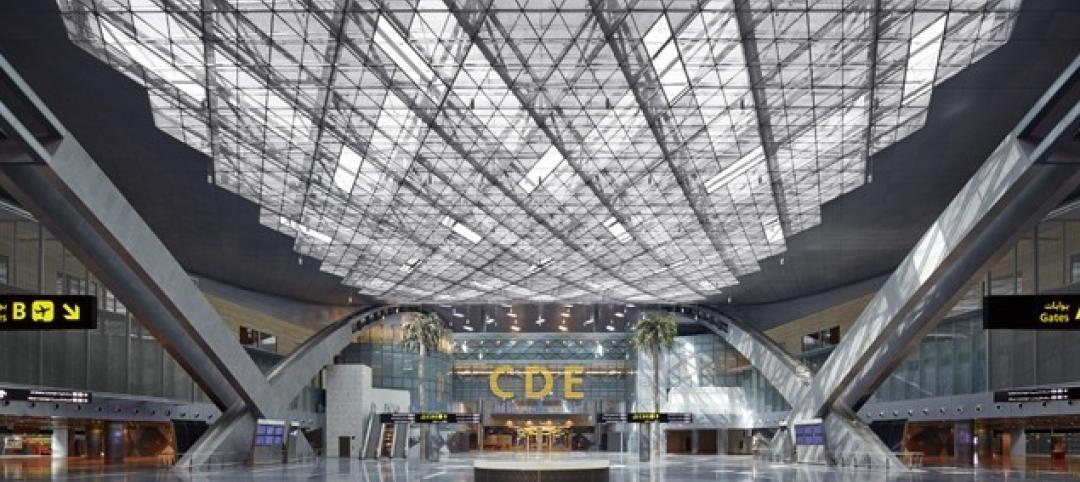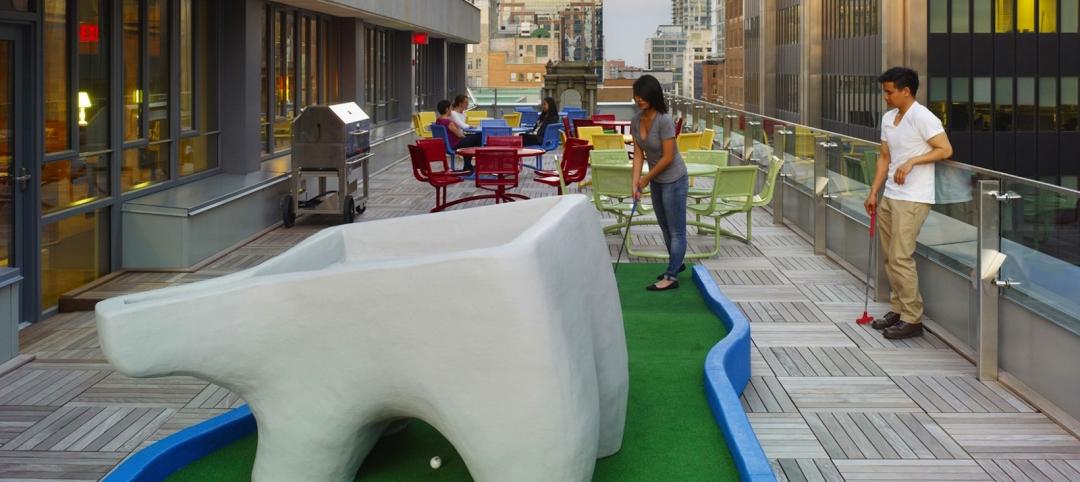People with high levels of emotional intelligence can recognize and understand emotions in themselves and others and then use this awareness to manage their behavior and relationships. Designers and facility managers need to understand the role of emotions in the workplace. When we incorporate strategies for enhancing people’s emotional intelligence, the work environments we create can improve employee engagement, health and productivity.
Engaged employees work harder because they have an emotional investment in creating value for their employer. Studies show a link between engagement and significantly higher performance levels. Work teams with the most engaged employees achieve higher productivity and profitability, better quality, higher customer satisfaction ratings and better employee retention rates. Meanwhile, they incur fewer safety incidents with less employee theft and absenteeism.
The American Psychological Association found that companies with highly engaged employees generate 19% more operating income. CEOs get excited by a 2% increase in earnings. Unfortunately, employee engagement rates are low. In a recent HOK study, only 11-13% of respondents reported feeling emotionally engaged at work. This is consistent with other industry studies.
This gap between engaged and unengaged employees represents an enormous opportunity for companies to make positive changes. If workplace designers can create environments that improve employee engagement, we can make dramatic contributions to our clients’ success.
Engagement is a CEO Priority
Many companies have made employee engagement a priority. The 2014 CEO Challenge Survey, which queries leaders from more than 1,000 companies worldwide, has identified human capital—how to best develop, engage, manage and retain talent—as the leading CEO challenge.
Respondents universally recognize the importance of developing an engaged workforce and a diverse, accountable leadership team.
For companies facing talent shortages, engagement can mean the difference between winning and losing the best people. Winners of the talent war will enjoy a snowball effect, as engaged employees will attract and create more people like them. Millennials, the young adults ranging in age from 18 to 34 in 2015, will not be wooed by money alone. Driven by purpose, many will move on if their jobs do not engage them.
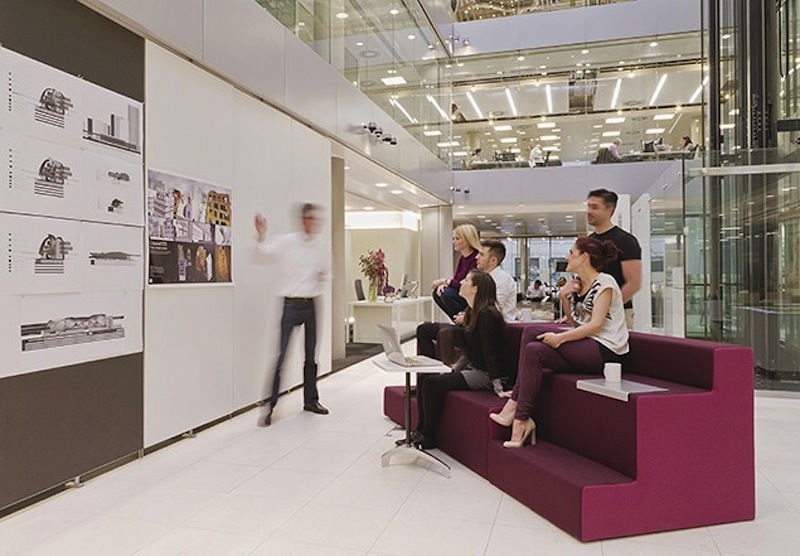 Image courtesy HOK
Image courtesy HOK
WHY ARE SO FEW EMPLOYEES ENGAGED?
Stress often triggers disengagement. Though it is an emotional response, stress causes physical reactions that make an individual feel highly alert but cognitively less productive. This is a powerful distraction with enormous workplace costs:
• In the United States, a study estimated the cost to employers of workplace stress that caused absenteeism, productivity losses and sick leave in 2010 to be US$300 billion (Worldcrunch.com).
• Sixty percent of lost work days are caused by stress (Centers for Disease Control and Prevention).
• Healthcare expenses are 50 percent higher for stressed workers (Journal of Occupational and Environmental Medicine).
• Forty percent of productivity losses come from cognitive overload, which occurs when people have too many emails, intense schedule demands, overlapping meetings, long to-do lists and unmet goals (American Psychological Association).
• One physical stressor that has a harmful impact on employee wellness and engagement is the amount of time people spend sitting every day. Too much sitting causes our organs to begin to shut down and hinders our ability to process energy.
Workplace designers can minimize physical stress by providing standing desks, exercise areas, access to daylight, ergonomic furniture, good acoustics and personal controls for lighting and temperature. But physical discomfort is not the only source of stress.
Emotional Suppression Causes Stress
Though many people are comfortable talking about stress in the workplace, few acknowledge or are willing to talk about the emotions that contribute to this anxiety. Yet we have emotional reactions to almost everything.
When we process information coming in from our senses, it first passes through our “reptilian brain.” This reactive part of the brain produces emotions before an experience reaches the higher levels of our conscious, rational brain, where it can be defined and controlled.
Our schools teach reading, writing, and arithmetic, and test for linear, logical thought. Yet they typically deemphasize emotional development, which devalues it as a success factor. Long before we enter the workforce, we have learned to leave our emotions at home. Traditional offices with cubed-off spaces then send a signal that only the rational part of an individual is welcome. Flexibility, agility and creativity don’t appear to have a place.
This history of emotional avoidance leaves many ill-prepared to deal with emotions in the workplace. If you’ve ever witnessed someone crying at their desk, tears falling onto the keyboard as they stoically try to carry on, you understand the futility of this emotional suppression and the stress it can cause. Yet that person will not be productive until he or she can control this emotion. If employees cannot speak about emotions in an intelligent, rational way at work, companies will miss opportunities to improve wellbeing, productivity and engagement.
The Employee-Employer Relationship is Not Authentic
Burying our feelings creates dishonesty in our conversations and relationships at work, which fosters disengagement.
Disengaged employees may be facing a personal or social crisis. They may be bored, confused about their responsibilities or irritated by environmental factors. Perhaps they perceive that they don’t have the tools, support or opportunities they need. Company leaders cannot address disengagement without having honest conversations about these emotional factors. In most cases, however, the employee-employer relationship lacks the foundation of trust required to achieve this level of honesty.
In “The Alliance: Managing Talent in the Networked Age,” LinkedIn cofounder Reid Hoffman and coauthors Ben Casnocha and Chris Yeh state that the reason 70% of American workers are not engaged is that the employee-employer relationship is based on a dishonest conversation. Neither is committed to a long-term relationship and neither will openly acknowledge this truth. Knowing that employers can fire them at will, employees spend lots of time searching for their next job.
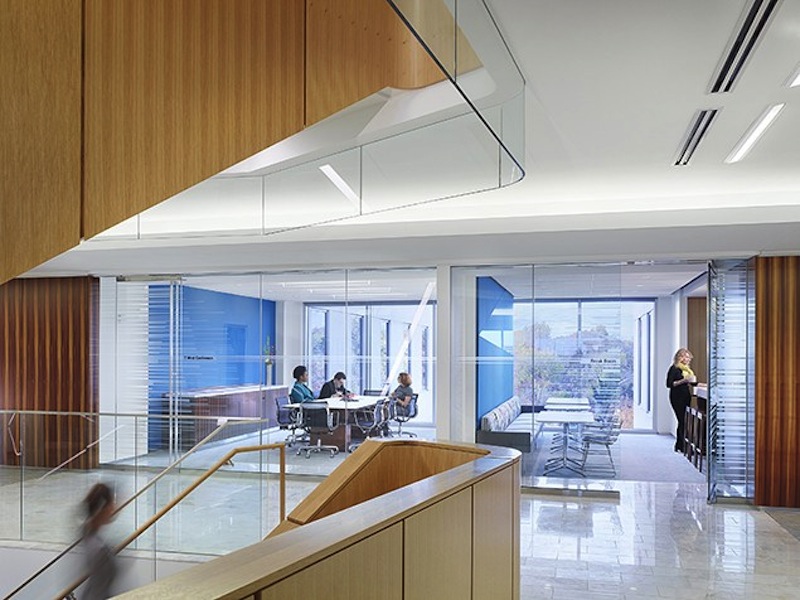 Image courtesy HOK
Image courtesy HOK
THE SOLUTION: EMOTIONAL INTELLIGENCE
A 2012 study by Ipsos found that while 91% of supervisors agreed that emotional intelligence is important, 75% of them were not strong in any of the four key areas of emotional intelligence. The good news is that emotional intelligence can be taught.
People can improve their emotional intelligence by identifying the emotions they are feeling, deciding how and when they will address them, and evolving into a less reactionary, more deliberate state of being.
Work environments can support this by providing spaces where people can go to relax and recharge. This makes them feel like management has given them permission to deal with their emotions, which helps them feel engaged.
Ensuring that their workplaces support emotional intelligence will help organizations attract and keep engaged employees, especially as the workforce continues to change.
Baby Boomers (aged 50 to 68), who were taught to keep their emotions to themselves, are retiring and a higher proportion of the workforce is made up of Generation X (34 to 49) and Millennial employees. The people from these younger generations grew up talking more about their emotions and having their feelings considered in family decisions from an early age. They expect two-way communication about their feelings, and the workplace can help accommodate and manage these expectations.
Emotional Intelligence Can Help Us Create Holistic Spatial Outcomes
Workplace design specialists are in a position to incorporate emotional intelligence to create holistic environments that promote the wellbeing and engagement of employees. We can support unique company cultures and create spaces where employees feel comfortable having honest, emotionally intelligent conversations. We can reduce stress and enhance productivity; help people focus and collaborate; and foster creativity, innovation and a sense of community.
We experience spaces like we experience people. We have a first impression and then, as a space becomes more familiar, a “deeper reality” sets in. An external design intention communicates to our senses and an inner intention is gradually revealed as we experience the space. As we use a space, we create muscle and neurological memories. For better or worse, we adjust to noise, uncomfortable chairs, rooms that are too small and technology that doesn’t meet our needs.
The workplace can cause or fulfill emotional needs. Abraham Maslow’s hierarchy of needs states that people are motivated to focus on higher-level needs only after they meet their lower-level needs. Fully engaged employees—those who create the most value—work at higher levels of the pyramid. Their biological, safety, social and esteem needs often have been met, and, ideally, the environment supports their cognitive, aesthetic and self-actualization needs. This enables them to contribute the most creativity, innovation and leadership. As designers and facility managers, it’s our job to create spaces that inspire people to function at these high levels.
By considering emotional intelligence during the design process, we can engage users on a deeper level. We can go beyond satisfaction surveys to measure feelings and emotional responses and then incorporate this intelligence into space planning, design and implementation.
Emoticons Enhance Our Ability to Measure Feelings and Emotions
Though we use hundreds of words to define specific emotions, they all stem from a few basic emotions. In 1972, anthropologist Paul Ekman described six core emotions based on universal human facial reactions: happiness, sadness, surprise, fear, disgust and anger.
Graphic depictions of these universal facial reactions have evolved into the emoticons used today to visually express emotion in printed or electronic communications. Emoticons, which may provide a more accurate measure of how people really feel at work, can add a new dimension to data collection. People can use emoticons to indicate their predominant emotions about workplace features. We can gauge emotional responses by showing images of different environments and asking people how they would feel in these spaces. Designers then can measure what’s important to their wellbeing and prioritize workplace elements that fill performance gaps.
Measuring emotional perceptions allows us to gain insight into differences within companies. Employees have different needs and expectations that influence their engagement levels. Different generations often have different reactions to their environments. Millennials may feel stifled in a cubical farm, while Baby Boomers may prefer a cubical to a shared desk in an open space. Culture, economic conditions, type of job and education are other factors that shape the workplace experience.
By leveraging emotional intelligence, designers can improve our awareness of the factors most relevant to engagement within client organizations and gain a deeper understanding of each client’s culture to optimize spatial outcomes.
We Must Integrate Change Management into the Design Process
An emotionally intelligent approach to workplace strategy requires change management.
Change management is a process that helps people through the change of moving to a new work environment. It is typically separated from the design process and led by experts who are well-versed in organizational strategy, HR and financial results. Though they may be familiar with emotional intelligence, change management specialists cannot achieve effective results if they don’t understand how space affects people and their performance.
A design team that understands the workplace strategy and that was involved in collecting the emotional data that informed that strategy will be better equipped to manage change. This team understands the space and how it will enhance the employees’ lives, relate to users’ needs, promote collaboration and enhance interaction, and reflect a company’s culture and work processes. This team can help people move from a cubical or siloed office to an open environment, where they must expand their sense of personal boundaries and property.
Workplace strategists seek holistic, integrated outcomes that bring balance into people’s work lives. We want to provide spaces that help people integrate the emotional and rational parts of themselves so they can perform at the highest level. If we ensure that change management is part of the workplace design process — and enhance it to become “change engagement” — we can build bridges that allow this to happen.
The Responsibility of Workplace Designers
Emotional intelligence enables employees to understand and harness emotions — their own or those of co-workers — to improve their performance. Work environments have a powerful impact on people and their emotional needs. As designers, we can contribute more to employee engagement, wellness and productivity when emotional intelligence is fully embraced in the workplace and reflected in the design strategies.
We have a responsibility to understand the role of emotions in the workplace, both obvious and hidden, and to adjust our design approach to achieve spatial outcomes that lead to highly engaged employees and dramatic bottom-line results for clients.
Designing an Emotionally Intelligent Workplace originally ran in the March/April 2015 issue of FMJ, the official magazine of the International Facility Management Association. For more information on FMJ, visit www.ifma.org/fmj.
About the Author: Sofia Fonseca, a recognized authority in architectural programming, is the Vice Presdient and Regional Leader of Workplace Strategy at HOK. She brings 20 years of experience providing visioning, workplace innovation, change management, programming and space planning services for clients throughout the world. More on Fonseca.
This article originally ran in the March/April 2015 issue of FMJ, the official magazine of the International Facility Management Association. For more information on FMJ, visit www.ifma.org/fmj.
More from Author
Life at HOK | Feb 6, 2015
6 factors steering workplace design at financial services firms
Grossly underutilized space and a lack of a mobility strategy are among the trends identified by HOK based on its research of 11 top-tier financial services firms.
Life at HOK | Jan 6, 2015
Airports apply technology to maximize hospitality
Technology is transforming the guest experience and enabling designers to reimagine a new hospitality-oriented destination airport terminal.
Life at HOK | Dec 28, 2014
The future of airport terminal design: destination status, five-star amenities, stress-free travel
Taking a cue from the hospitality industry, airport executives are seeking to make their facilities feel more like destinations, writes HOK's Richard Gammon.
Life at HOK | Nov 17, 2014
Hospitality at the workplace: 5 ways hotels are transforming the office
During the past five years, the worlds of hospitality and corporate real estate have undergone an incredible transformation. The traditional approach toward real estate asset management has shifted to a focus on offerings that accommodate mobility, changing demographics, and technology, writes HOK's Eva Garza.
Life at HOK | Oct 13, 2014
The mindful workplace: How employees can manage stress at the office
I have spent the last several months writing about healthy workplaces. My research lately has focused on stress—how we get stressed and ways to manage it through meditation and other mindful practices, writes HOK's Leigh Stringer.
Life at HOK | Sep 9, 2014
Using Facebook to transform workplace design
As part of our ongoing studies of how building design influences human behavior in today’s social media-driven world, HOK’s workplace strategists had an idea: Leverage the power of social media to collect data about how people feel about their workplaces and the type of spaces they need to succeed.
Life at HOK | Aug 16, 2014
The science of learning: Designing the STEM learning facilities of the future
New technology and changing pedagogies are influencing how to best teach a generation of learners who have never known a world without smartphones or tablets, writes HOK's Kimberly Robidoux.
Life at HOK | Aug 5, 2014
Will driverless cars kill the parking structure?
A report from Deloitte highlighted how driverless cars could dramatically alter car ownership in the future, pushing the pendulum from ownership to rentals and ride sharing.
Life at HOK | May 19, 2014
What can architects learn from nature’s 3.8 billion years of experience?
In a new report, HOK and Biomimicry 3.8 partnered to study how lessons from the temperate broadleaf forest biome, which houses many of the world’s largest population centers, can inform the design of the built environment.
Life at HOK | Jan 30, 2014
How reverse engineering nature can spur design innovation
It’s not enough to copy nature. Today’s designers need a deeper understanding of environmental nuance, from the biome in.

